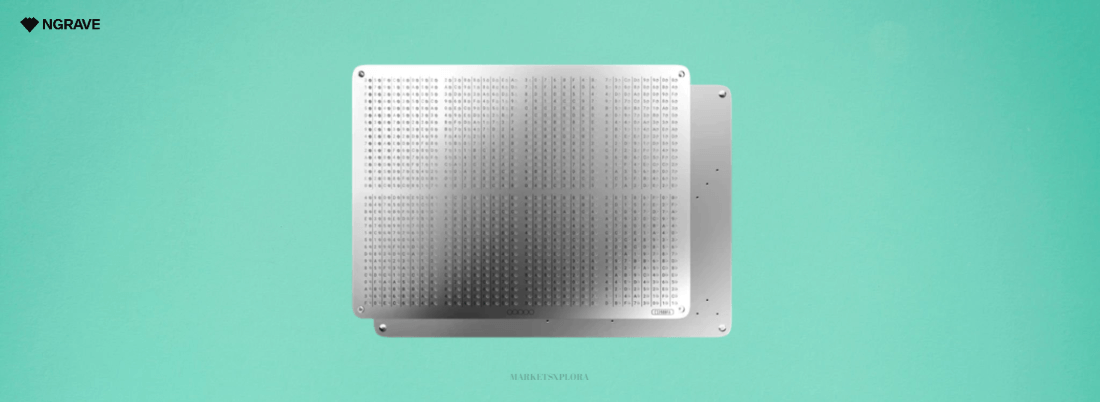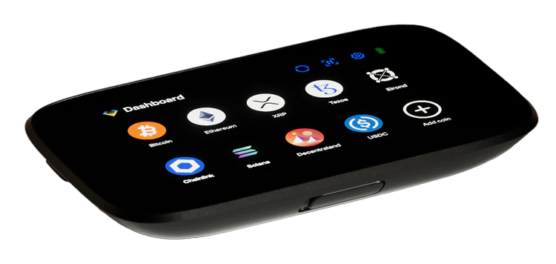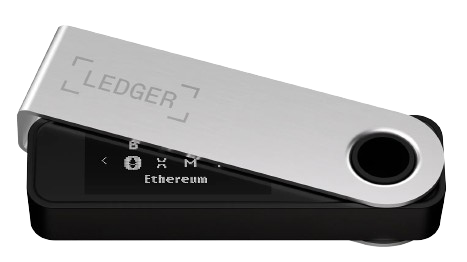
Cryptocurrency hardware wallets like the Ngrave Zero and Ledger Nano S Plus aim to provide robust defenses for valuable digital assets. By safeguarding private keys offline and utilizing various encryption measures, they offer more security than software or web wallets.
This Ngrave Zero vs Ledger Nano S Plus comparison looks in-depth at key criteria separating two popular choices – from protection and certifications to usability and customizability for diverse investors.
Ngrave Zero vs Ledger Nano S Plus Quick Comparison
| Category | Ngrave | Ledger |
|---|---|---|
| Security Protocol | 100% Offline 🚫🌐 | Partially Online 🌐 |
| Wallet Access | Biometrics 👤 | PIN Only 🔒 |
| Backup Method | Durable Steel Cards 🛡️ | Paper Phrases 📜 |
| Supported Assets | 1500+ Native 💱 | 5500+ w/Apps 📱 |
| Screen Interface | 4″ Touchscreen 🖥️ | Single Button 🛑 |
| Dimensions | Larger and Heavier 📏🏋️ | More Portable 📐👜 |
| Price | $398 💰 | $79 💵 |
| Accessory Costs | Extra Charges 💳 | Bundled 🎁 |
Security
When it comes to securing your valuable cryptocurrency assets, the Ngrave Zero and Ledger Nano S Plus take distinct approaches.
Encryption & Storage
The Ngrave Zero generates and stores private keys fully offline, leveraging no network connections by eschewing even wired physical connectors with uncompromising cold storage. Meanwhile, the Ledger Nano S Plus isolates keys partially on secure chips still wired via USB cables, a grey area between hot wallets reliant on internet connectivity and disconnected cold storage.
Backup Recovery Options
For backup and recovery, Zero utilizes Graphene steel plates for stamped unguessable alphanumeric keys etched into durable fireproof metal. Ledger relies on conventional paper phrases more prone to physical degradation over time.

Security Certifications
External security certifications validate resilience measures too. Ngrave utilizes bank-grade CC EAL7 certification validating resilience against state-level dedicated hacking attempts. Ledger only meets the lower CC EAL5+ standards often adequate for software solutions. However, Ledger does incorporate a customized real-time OS.
Physical Tamper Resistance
Both utilize sturdy metal housings with tamper detection, but Ngrave seemingly has adopted more advanced anti-penetration mechanisms capable of wiping devices if breached.
Ultimately for unconditional security purists, Ngrave Zero’s uncompromising design and industry-certifications distance its protections from the Ledger Nano S Plus still partially tethered to online attack surfaces. Yet both achieve respectable security well beyond software if wielded responsibly.
Winner – Ngrave Zero
By wholly eliminating wired connectivity through an exclusively offline operating environment backed by EAL7 certifications, the Ngrave hardware wallet sets the bar for Bitcoin and cryptocurrency security against persistent threats.

Supported Assets
Supported Cryptos
The Ngrave Zero integrates 1500+ cryptocurrency projects including leading networks like Bitcoin, Ethereum, Cardano, and Solana natively without installing external wallet apps.

This allows direct control any supported asset via the touchscreen. Meanwhile, Ledger supports over 5500 coins through installable companion apps that bridge its secure enclave to desired blockchains, an exponentially wider range but dependent on custom software.
Blockchain Network Compatibility
Currently, Ledger connects broadly across niche ecosystem players like Harmony, VeChain, and Tezos that Ngrave has yet to officially bring into its unified firmware environment. But core mainstream chains like BNB Smart Chain, Polygon, Optimism, Arbitrum, and Kadena share joint support. Ledger apps enable tailored customization while Ngrave focuses on seamless consolidation.
NFT Asset Compatibility
For accelerating NFT markets, the Zero smoothly facilitates Ethereum and MultiVAC collectibles using ERC-721 transaction signing without third-party software. Ledger devices presently lack native NFT transaction handling capabilities for minting or trading crypto art and digital goods, hindering direct storage and movement. Partial workarounds exist but remain third-party dependent.
Winner – Ledger Nano S Plus
The Ledger connects with over 5,500 different coins and tokens. It uses add-on apps to make this happen. The Ngrave Zero only natively supports 1,500 assets directly with no apps needed. Over 3 times more choice and flexibility makes Ledger the winner for most investors.

Setup & Use
Initial Configuration & Backup
The Ngrave Zero’s strictly offline setup process allows private key generation and engraved steel backups without ever touching insecure internet connections. This surpasses Ledger’s web-dependent recovery phrase approach prone to malware and remote logging. However, Ledger shines integrating with Windows/Mac desktop software for monitoring portfolios.
Account and Portfolio Management
On usability, the Zero’s intuitive 4-inch touchscreen enables direct asset interaction instead of Ledger’s smaller screen and single-button account switching. But Ledger permits installing multiple apps to compartmentalize access. The Zero consolidated experience scales better for large portfolios.
Transaction Signing and Processing
Both platforms feature secure signing mechanisms to authorize outbound crypto transfers – Ledger relies on two-factor physical confirmations across devices while Ngrave accomplishes this more seamlessly via scannable QR codes bridging its mobile app and hardware wallet.
Mobile and Desktop Compatibility
For desktop support, Ledger maintains superiority with its Windows and Mac-based apps plus browser extensions. But reliance on those attack surfaces erodes security advantages. The Zero centers around mobile syncing, albeit with fewer wallet pairing options presently.
When weighing key usability metrics surrounding device setup, account management, transaction handling, and desktop/mobile properties, Ngrave Zero streamlines the self-contained experience while Ledger’s strength lies in complementary desktop software integration – albeit at the cost of privacy.
Winner – Tie

Cost Considerations
Device Pricing
The $79 (€70) Nano S Plus dramatically undercuts the higher-priced $470 (€399) Ngrave Zero. Those cost-conscious may view Ledger as the value pick while security maximizers lean towards Zero.
Disaster Recovery Expenses
Replacing lost devices runs reasonably $119 for new Nanos but restoring Zero access via recovery cards costs over $500, limiting worst-case scenarios. Ledger unambiguously wins on replacement wallet costs.
Accessory Pricing
Ngrave charges added fees for spare chargers, cables, or Zero screen protectors that Ledger bundles by default. These little extras add up, again putting Ledger ahead on overall pricing.
Winner – Ledger Nano S Plus
By decisively winning on device affordability upfront supplemented by cheaper disaster recovery and accessory costs long-term, the Ledger hardware wallet prevails on cumulative wallet expenditures making security reasonably accessible.

Hardware Design
Display Size and Type
Ngrave Zero sports a substantially larger 4” touchscreen dwarfing the Ledger’s minuscule interface relying on a single scrolling button for operation. But added size hampers subtle portability.
Physical Dimensions and Weights
Similar stainless steel and metal alloy construction results in the Zero measuring significantly wider and heavier at 6.3oz than the compact 2.7oz Nano S Plus designed for mobility.
Durability
Waterproofing, drop testing, and resilience certifications against environmental factors appear nearly identical across both hardened cases shielding sensitive internals from incidental damage.
Biometric Authentication Factors
Ngrave allows biometric fingerprint unlocking for an added authentication layer beyond conventional PIN codes which Ledger lacks. It helps restrict unwanted access attempts.
Basic Portability Yielding Security
The Ledger Nano X Plus simply fits better in pockets, bags, and travel cases for everyday carry, prioritizing on-the-go usage above all else by majority consumers.
For physical wallet attributes, while Ngrave Zero touts flashy additions like touchscreens and biometrics, the Ledger Nano S Plus form factor caters directly to portable usability at the expense of headline features.

Verdict – Buy Ngrave Zero or Ledger Nano S Plus?
Between the Ngrave Zero and the Ledger Nano S Plus, which hardware cryptocurrency wallet should you buy? Here is the easiest way to decide:
Get the Ngrave Zero if protecting your money against hackers, thieves or losing devices is the most important thing. The Ngrave costs more but keeps your private keys totally offline away from any website or apps. This prevents it from getting hacked. It’s also built tougher for real-world protection against damage or losing it. Security is its biggest strength.
Get the Ledger Nano S Plus wallet if you want to use lots of different cryptocurrency coins, blockchain apps, or NFT platforms from one device. It connects to over 5500 assets. It also works with more niche crypto networks. But it still offers good safety just below Ngrave’s level because your keys touch the internet briefly. For most people who need flexibility across many assets, Ledger fits best.
So in short:
- Ngrave Zero if security is everything
- Ledger Nano S Plus if you need wide support for assets
Both are good options. Choose what matters to you more – maximum safety or maximum compatibility across cryptos and chains. Avoid software wallets for large savings.
If you found this Zero vs Nano S Plus comparison insightful, remember to also check out our Ngrave Zero vs Ledger Stax and Ngrave Zero vs Ledger Nano X reviews to help identify your best-fit wallet.
FAQs
- Which hardware wallet supports more cryptocurrency coins?
The Ledger Nano S Plus supports over 5,500 cryptocurrencies through installable apps whereas Ngrave directly supports 1500+.
- Which offers stronger physical data protection assurances?
The Ngrave Zero offers superior physical data protection given the advanced tamper-proofing ability to wipe devices when penetrated. Both utilize durable metals, however.
- What is the price difference between Ngrave Zero and Ledger Nano S Plus?
The Ngrave Zero costs around $398 at retail while the Ledger Nano S Plus is sold for $79.
- Can Ngrave smoothly connect with popular DeFi wallet interfaces?
Not yet. Ngrave focuses heavily on mobile compatibility whereas Ledger enables smoother DeFi desktop wallet usage currently through helper apps.
- Does the Ngrave Zero wallet utilize fingerprint biometric unlocking?
Yes, the Ngrave Zero offers optional fingerprint biometric authentication for enhanced account security, a feature Ledger wallets lack.
